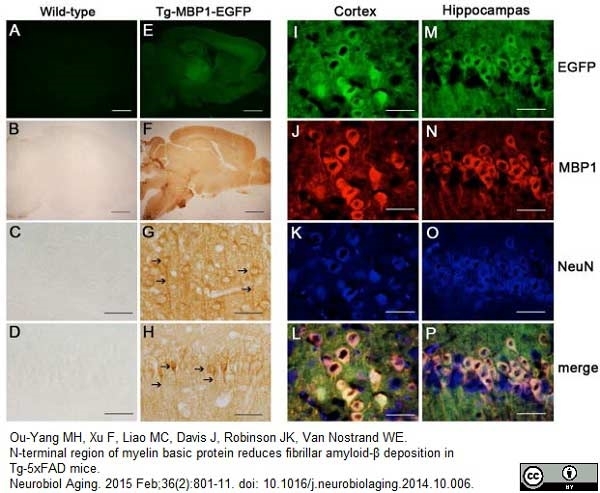MBP antibody | 14

Rat anti MBP (aa36-50)
- Product Type
- Monoclonal Antibody
- Clone
- 14
- Isotype
- IgG2b
- Specificity
- MBP
- Region
- (aa36-50)
| Rat anti MBP antibody, clone 14 recognizes myelin basic protein (MBP), a component of myelin that is beleived to play a role in the myelination of nerves in the central nervous system. Rat anti MBP antibody, clone 14 has also been reported to work in western blotting (Relucio et al. 2009). |
- Target Species
- Bovine
- Species Cross-Reactivity
-
Target Species Cross Reactivity Human Chicken Expected from Sequence Horse Expected from Sequence - N.B. Antibody reactivity and working conditions may vary between species.
- Product Form
- Tissue Culture Supernatant - liquid
- Buffer Solution
- 0.1M TRIS
- Preservative Stabilisers
- <0.1% Sodium Azide (NaN3)
- Immunogen
- Bovine myelin basic protein
- Fusion Partners
- Spleen cells from immunized outbred rats were fused with cells of the mouse NS0 myeloma cell line.
- Regulatory
- For research purposes only
- Guarantee
- 12 months from date of despatch
Avoid repeated freezing and thawing as this may denature the antibody. Storage in frost-free freezers is not recommended.
| Application Name | Verified | Min Dilution | Max Dilution |
|---|---|---|---|
| ELISA | |||
| Immunofluorescence | |||
| Immunohistology - Frozen 1 | |||
| Immunohistology - Paraffin |
- 1The epitope recognised by this antibody is reported to be sensitive to formaldehyde fixation and tissue processing. Bio-Rad recommends the use of acetone fixation for frozen sections.
References for MBP antibody
-
Groome, N.P. et al. (1986) Region-specific immunoassays for human myelin basic protein.
J Neuroimmunol. 12 (4): 253-64. -
Glynn, P. et al. (1987) Basic protein dissociating from myelin membranes at physiological ionic strength and pH is cleaved into three major fragments.
J Neurochem. 48 (3): 752-9. -
Groome, N. et al. (1988) New monoclonal antibodies reactive with defined sequential epitopes in human myelin basic protein.
J Neuroimmunol. 19 (4): 305-15. -
Matsuo, A. et al. (1997) Unmasking of an unusual myelin basic protein epitope during the process of myelin degeneration in humans: a potential mechanism for the generation of autoantigens.
Am J Pathol. 150: 1253-66. -
Jackson, S.J. et al. (2004) Cannabinoid-mediated neuroprotection following interferon-gamma treatment in a three-dimensional mouse brain aggregate cell culture.
Eur J Neurosci. 20: 2267-75. -
Friess, M. et al. (2016) Intracellular ion signaling influences myelin basic protein synthesis in oligodendrocyte precursor cells.
Cell Calcium. 60 (5): 322-30. -
Ou-yang, M.H. et al. (2015) N-terminal region of myelin basic protein reduces fibrillar amyloid-β deposition in Tg-5xFAD mice.
Neurobiol Aging. 36 (2): 801-11. -
Biffi, A. et al. (2006) Gene therapy of metachromatic leukodystrophy reverses neurological damage and deficits in mice.
J Clin Invest. 116 (11): 3070-82.
View The Latest Product References
-
Copray, J.C. et al. (2005) p75NTR independent oligodendrocyte death in cuprizone-induced demyelination in C57BL/6 mice.
Neuropathol Appl Neurobiol. 31 (6): 600-9. -
Jagielska, A. et al. (2017) Mechanical Strain Promotes Oligodendrocyte Differentiation by Global Changes of Gene Expression.
Front Cell Neurosci. 11: 93. -
Dias, D.O. et al. (2021) Pericyte-derived fibrotic scarring is conserved across diverse central nervous system lesions.
Nat Commun. 12 (1): 5501.
- Synonyms
- Myelin Basic Protein
- RRID
- AB_325007
- UniProt
- P02687
- Entrez Gene
- MBP
- GO Terms
- GO:0005886 plasma membrane
- GO:0005515 protein binding
- GO:0019911 structural constituent of myelin sheath
- GO:0043209 myelin sheath
MCA408S
If you cannot find the batch/lot you are looking for please contact our technical support team for assistance.
Please Note: All Products are "FOR RESEARCH PURPOSES ONLY"
View all Anti-Bovine ProductsAlways be the first to know.
When we launch new products and resources to help you achieve more in the lab.
Yes, sign me up